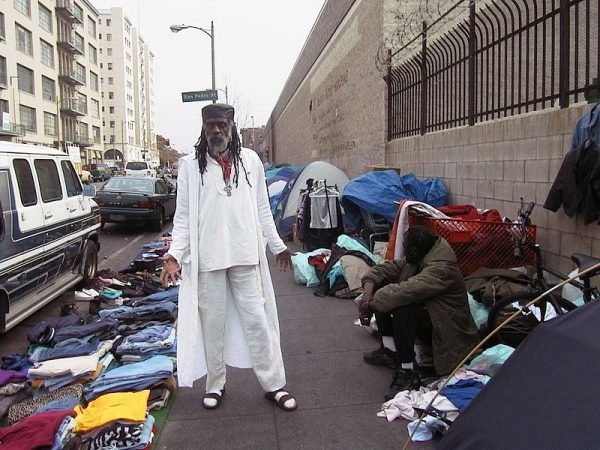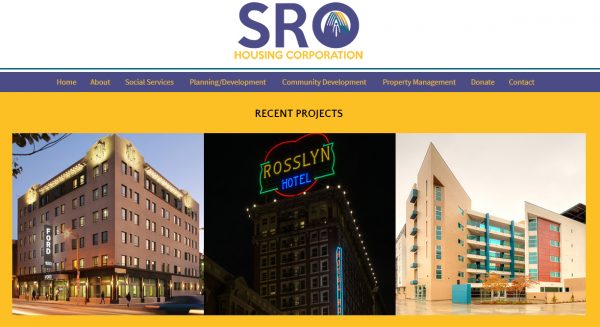It’s hard to overstate the vastness of the Skid Row neighborhood in Los Angeles. It spans roughly 50 blocks, occupying a significant portion of the downtown Los Angeles area. In some ways, it looks a lot like other neighborhoods with its corner stores and street vendors, old brick townhouses and people gathered in its public spaces. But it’s also very clear when you’ve entered Skid Row.
For one thing, there’s the smell. The streets of Skid Row often stink of urine and excrement baking under the hot Los Angeles sun. The gutters are lined with trash. And the sidewalks are mostly occupied by makeshift homes. A dizzying array of tarps and tents stretch out for blocks, improvised living structures sitting side by side.
And there are lots of people on the street, many of them pushing special red shopping carts. The carts are handed out by a local advocacy group because the police used to arrest people for having what they believed were stolen shopping carts. “So all a person gotta do is just be homeless and register and come here and they give you a shopping cart,” explains General Dogon, a community organizer and lifelong resident of the neighborhood. He has lived in both low-income housing and on the streets in the area for decades.
The edge of Skid Row is also clearly defined. “Main Street is the dividing line between the haves and have-nots,” says Dogon. “You’ve got homeless people sleeping on one side of the street, and the loft buildings on the other side of the street.” And this dividing line wasn’t drawn by accident. It’s the result of a very specific plan to keep homeless people on one side and development on the other. And, perhaps surprisingly to outsiders: it’s a plan that Skid Row residents and their allies actually designed and fought for.
Back in the early 20th century, the railroad went through downtown Los Angeles, right around where Skid Row is now. And, like in many other cities around the country, a neighborhood formed around the train tracks. Los Angeles city planner Bryan Eck explains that initially there weren’t any zoning restrictions, and the rail and produce markets around that area “brought a large transient population in terms of the railroad workers and agricultural workers.”

Until the 1970s, most people in Skid Row lived in cheap apartments or single room occupancy hotels (also known as “SROs”). There were homeless people, but fewer than there are now. Skid Row was not yet the sprawling tent city that it would eventually become, but it was still considered a rough neighborhood where people went to find drugs or to drink all day and sleep on benches.
As Skid Row grew, the greater downtown area of LA was also growing and developing, and a plan emerged in 1972 to move Skid Row’s population out. Drafted by a group of local businesses and endorsed by many city officials, the so-called “Silver Book Plan” essentially called for Skid Row to be razed to make room for more development.
Activists, meanwhile, began thinking about how to fight back. They argued that demolishing Skid Row would just cause the population to spread out and relocate within the city. And thus an unlikely alliance was born: Skid Row activists and scared residents of other neighborhoods who didn’t want Skid Row in their backyard. A “Blue Book Plan” was pitched as an alternative to the “Silver Book Plan.” This new plan proposed a policy of containment.

The containment plan advocated some pretty radical ideas, including pushing all the missions and charities and other homeless services to relocate within the newly-drawn borders of Skid Row. In return, the Los Angeles Redevelopment Agency would largely leave the area intact. And they would also form the SRO Housing Trust, charged with protecting and maintaining low-income housing in Skid Row.
The containment plan was enough of a compromise that it managed to win out over the competing plan to demolish Skid Row. It wasn’t a legally binding agreement, but it went on to define the city’s approach to this area for decades. And it was a totally unique approach, designed to use “inducements” to keep area residents within the confines of their neighborhood as much as possible. Amenities would exist within Skid Row, but strong borders around the edges would form a “buffer zone.” The actual text of this containment plan was at times quite harsh:
“With public restrooms, benches, and pleasant open spaces within the contained area of Skid Row, the residents might be inclined to confine their activities to the immediate area. That section would serve as a magnet to hold undesirable population elements in Skid Row, not against their will but of their own accord. Strong edges will act as buffers between Skid Row and the rest of the central city. When the Skid Row resident enters the buffer, the psychological comfort of the familiar Skid Row environment will be lost; he will feel foreign and will not be inclined to travel far from the area of containment.”
Activists who wrote and backed the plan say that if the writing sounds unsympathetic or even offensive, it’s because they weren’t trying to run a public relations campaign to change people’s minds — they were just desperately, frantically, trying to save Skid Row from being destroyed. And containment, they argued, was better than letting the area get bulldozed and redeveloped entirely.
After the containment policy was officially adopted in 1976, the city started to implement it — including many of its meticulous and uncomfortable suggestions of how, exactly, to contain Skid Row’s population. Among other things, “unpleasant design” strategies, like annoyingly bright lights, were used on Skid Row’s bordering streets, to keep homeless people from wanting to expand their territory.
“Main Street always had the regular fancy lights,” recalls General Dogon. “The old metal ones that bent down, and that was it.” These were replaced by what he describes as bright prison lights “targeting people who, like me, would come outside the front of the SRO” to hang out and smoke cigarettes on the sidewalk. Police officers were also more likely to leave people alone if they stayed within the borders of the containment zone.
The containment approach made some practical sense both for the city and the residents of Skid Row, but it’s also a somewhat dehumanizing idea. “It’s a warehouse zone,” says Dogon, and “a warehouse is where you store shit. So the idea was to push all of Los Angeles’s unfavorable citizens into one area.”

For better or worse, over the course of just a few years, LA’s Skid Row became the place to go if you were homeless in Los Angeles. It offered meals, showers, bathrooms, and other necessities. Some hospitals would even discharge patients to Skid Row if they didn’t have a fixed address.
In many ways, the city was funneling its homeless population into the area — a population growing fast in the 1980s due to the crack epidemic. The rise of President Ronald Reagan’s “War on Drugs” and the government’s aggressive cuts to the welfare system meant the homeless population was exploding. Skid Row went from being mostly white male alcoholics to being overwhelmingly black, with families on the streets who could no longer afford rooms in SROs.
But in the last couple of decades, conditions on Skid Row have changed a bit. There are fewer homeless people and they no longer sleep shoulder-to-shoulder on the street. Nevertheless, Skid Row has endured as a place for homeless people to live and find services — even as other similar neighborhoods around the country have been eaten up by gentrification and their residents scattered around their respective cities. Over the years, the sense of community in Skid Row has also gotten stronger. The neighborhood’s become not just a hub for social services, but for activism around poverty and homelessness.

Apart from the containment plan, there’s another major reason why Skid Row has not been taken over by new apartment buildings: zoning. Aside from the SROs — and a scattering of other low-income housing that was grandfathered in — most of Skid Row is zoned industrial rather than commercial or residential.
But all of that could soon change. Los Angeles is currently undertaking a total overhaul of its zoning code, starting with downtown, and a lot of Skid Row will probably be rezoned as mixed-use. There are a lot of vacant buildings in Skid Row, and the city would like to make some of that real estate available for housing
Unfortunately, rezoning would pave the way for places that would be largely unaffordable to current residents. Craig R., a longtime resident, says zoning is just “the tool they want to use to get rid of the homeless people, to create this new gentrification program. And they’re planning on making billions of dollars on pushing us out, squeezing us out, or kicking us out, meaning us the poor people, the disadvantaged people, the homeless, plus the residents of the neighborhood.”
Even without zoning changes, Skid Row is getting smaller. The containment plan was never a legally binding agreement and the city seems to be increasingly ignoring its advice. There’s a whole new hip neighborhood that juts up against Skid Row (and used to be part of it), filled with art galleries and chic cafés. It’s called the Arts District. And as the areas around Skid Row have continued to gentrify, taking bites out of the edges of the neighborhood, Skid Row itself has changed — the police presence is now much stronger, even within the containment area.

Back in 1976, when activists came up with the containment plan, they included a map that laid out exactly what the borders of Skid Row would be. They were trying to make a deal — a kind of compromise — to ensure residents would be left alone. Now, the focus of containment has shifted — instead of trying to contain Skid Row residents, activists are trying to contain development and to keep the rest of the city from crowding in.



Comments (1)
Share
Love the show. One of my very favorites. Sadly I’d fail a coin check. Bad timing there.
In this show, Nate said that you can’t lower housing costs with rezoning, only with legislation. It’s probably true that rezoning a part of Skid Row wouldn’t improve housing costs. It might even raise housing costs by increasing desirability and speeding ongoing gentrification. But a comprehensive, city-wide rezoning to favor higher-density residential housing might do the trick. https://www.buildzoom.com/blog/paying-for-dirt-where-have-home-values-detached-from-construction-costs Anyway, legislation would be good too.